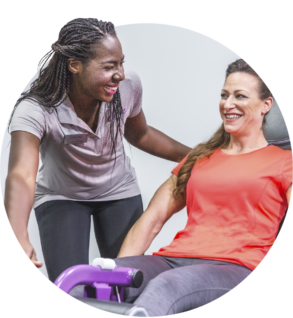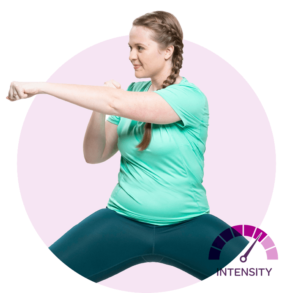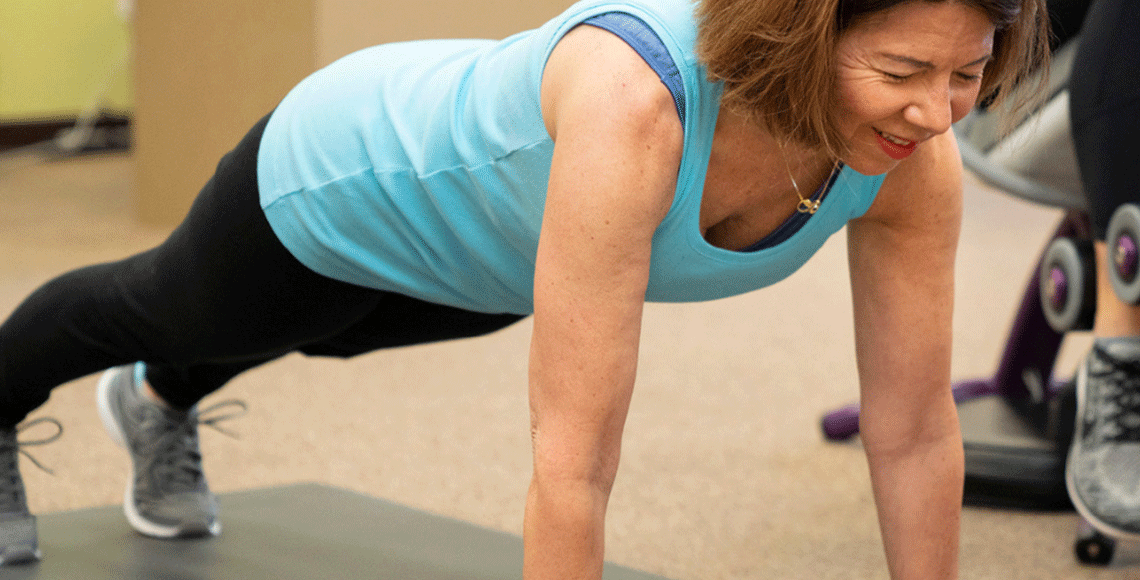The Power of The Pelvic Floor
Do you cross your legs every time you sneeze? Refuse to get on the trampoline with the kids? Or hold back a hearty laugh to avoid running to the closest bathroom? If you answered “Yes” to any of these questions, you may have a weak pelvic floor.
First, if these scenarios sound painfully familiar, rest assured you’re not alone. Bladder incontinence is one of the most common complaints in women. Many of us chalk it up to childbirth or simply getting older, but bladder incontinence is not something you have to continue to live with. Research shows that the right pelvic floor exercises can reduce symptoms of incontinence, and in some cases, treat the condition. The Curves’ Health and Wellness Education Series class Strengthen Your Pelvic Floor can help and is available both at participating clubs and online.
What is the Pelvic Floor?
The pelvic floor is a group of muscles at the base of your pelvis, or at the bottom of your torso. Your pelvic floor muscles help support the organs in your pelvis, including the bladder, uterus, and rectum, by wrapping around your pelvic bone.
Pelvic floor muscles can weaken after the pressure of pregnancy and childbirth and also with age. In severe cases, the resulting bladder and bowel incontinence can take a real overall toll on women’s wellness.
The good news is that there are things you can do to strengthen pelvic floor muscles. And stronger pelvic floor muscles not only help improve bowel and bladder control, they can also reduce the risk of bladder prolapse; increase sexual sensation and decrease pain during sex; speed recovery after gynecological surgery; and improve overall confidence and quality of life.1
Exercises to Strengthen the Pelvic Floor
One of the best ways to strengthen the pelvic floor is to get right to the source and perform pelvic floor exercises for women. You can learn how to perform these exercises in the Strengthen Your Pelvic Floor Health and Wellness Class.
Kegel exercises
Kegel exercises were developed in the late 1940s by an American gynecologist named Arnold H. Kegel to strengthen the pelvic floor and prevent urinary incontinence in women. Kegels are an effective exercise to strengthen the pelvic floor muscles…if you perform them the right way. One-third of women do Kegel exercises incorrectly and work their inner thigh, abdominal, or glute muscles instead. To make sure you’re working the right muscles, first, find them. Squeeze the muscles you would contract if you were tightening your vagina around a tampon or trying to avoid passing gas. You should feel the muscles contract more in the back of your pelvis than the front. To do Kegels, go through the following steps:
- In a sitting or standing position, contract your pelvic floor muscles and hold for three to five seconds
- Then relax the muscles for three to five seconds
- Repeat this cycle 10 times to strengthen your pelvic floor muscles
- Over time, work up to contracting the muscles for 10 seconds
- Try to do three to four sets of Kegel exercises per day.2
Squats
You may not necessarily think of squats when you think of pelvic floor exercises for women, but when done correctly, squats are a great way to strengthen your pelvic floor. Your glute muscles will thank you, too. To perform a squat correctly to strengthen the pelvic floor, do the following:
- Stand with your feet hip-width apart, flat on the floor. Make sure your feet aren’t too far apart; wide-legged squats work different muscles and make it difficult to target the muscles in your pelvic floor.
- Engage your core to ensure you are not bearing down on your pelvic floor.
- Bend your knees, keeping your knees in line with your toes, and slowly drop your buttocks to the floor. Go as far down as you can comfortably, keeping your back straight and leaning forward.
- Slowly return to your starting position, tightening your glute and pelvic floor muscles as you stand.
- Do 10 repetitions.3
Hip Bridges
Bridge lifts are a good exercise to strengthen the pelvic floor, and they strengthen your glutes and open your chest, too. To perform a bridge lift, do the following:
- Lie on your back with your knees bent, feet flat on the floor.
- Place your hands by your sides, your palms facing down.
- Press your hips up toward the ceiling, lift your butt off the floor. Do not lift your hips up so high that you feel an arch in your lower back; keep a neutral spine.
- Pause for one to two seconds at the top, then lower your butt back down.
- Do 8 to 12 reps.4
At Curves, we have more than 30 years of experience in women’s wellness, helping them to achieve happier, healthier lives. Learn these exercises and more in the Strengthen Your Pelvic Floor Health and Wellness Class. Sign up for the class today and learn how to manage your symptoms so you can enjoy your life without constantly scouting for the closest ladies’ room. Plus, you’ll boost your confidence and improve your overall quality of life, too!
Your Curves Coach is there to lead you through every gym workout. With your Curves Coach success is within reach. Visit ‘Why Curves‘ to find out more about Curves women’s only gyms and our full body workout on the Curves Circuit, or find your local Curves and sign up today! Find your local Curves here!
Sources:








